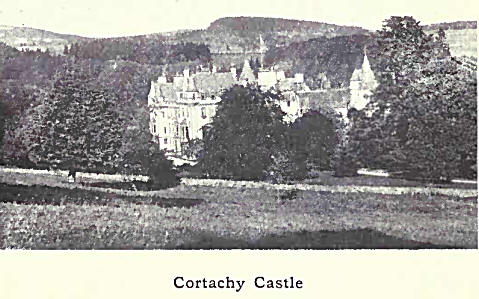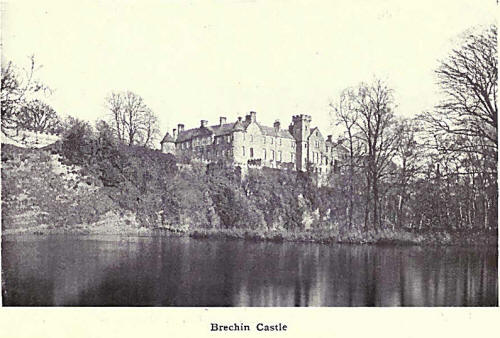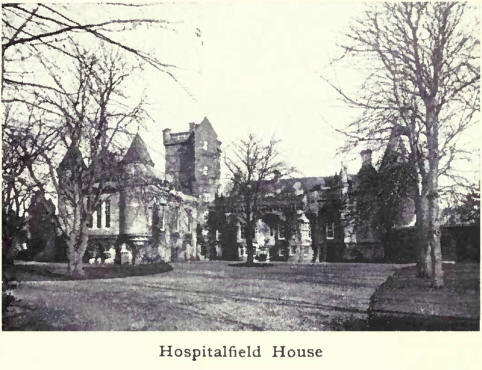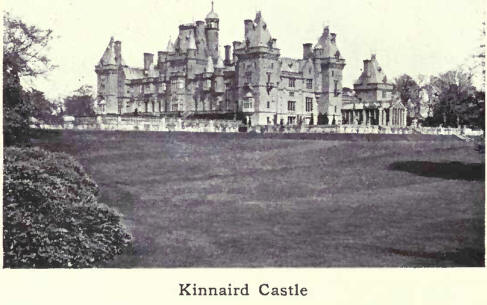|
The year of the Union
of the Crowns may be taken as marking the change from dwellings
designed for protection to those aiming at convenience, health and
comfort; and within the seventeenth century accordingly, proprietors
of wealth and enlightened taste began to add to their castles or to
transform gloomy fortalices into residences better suited to their
requirements. As the eighteenth century advanced, the love of the
classic, or pseudo-classic, in art was modified or superseded by a
passion for the romantic and a veneration for the past; and hence
proprietors and architects sought to give prominence, in at least
the outward appearance of edifices, to those characteristics for
which the older parts had teen distinguished and to harmonize as far
as might be modern alterations and additions with architectural
ideals of more primitive times. Of this blending of the new with the
old there are many excellent examples in Forfarshire.

Cortachy Castle
exhibits the mingling of architecture of different dates—it was not
completed till after the middle of last century—but all the parts
unite in one superb whole. The interior also is full of interest.
The vaulted Charter Room holds the family records, and the “King’s
Room” was occupied by Charles II on his memorable “Start” from his
austere covenanting supporters in 1650. In the magnificent grounds
is the “Garden of Friendship,” where notable visitors have from time
to time planted trees.
To the north of
Kirriemuir stands the mansion of Kinnordy, purchased by the Lyells
from the Ogilvys of Inverquharity. The old part of the house was
built over a century ago and was that in which Sir Charles Lyell,
the geologist, lived and studied; but his nephew, Sir Leonard Lyell,
M.P., had it entirely reconstructed in 1880, so that it is now one
of the most ornate mansions in the county.
The ancestors of
Admiral Duncan, who defeated the Dutch fleet off Camperdown in 1797,
purchased the estate of Lundie. Finding the castle that belonged to
the estate unsuitable as a dwelling, the first Earl of Camperdown
built the modern mansion in 1828, naming it after the scene of his
father’s great victory. Camperdown House, situated in the midst of
magnificent and spacious policies, is built of white sandstone in
Grecian style, and has a fine portico supported by noble Ionic
pillars. An interesting relic in the grounds is the figure-head of
the Dutch admiral’s ship, a lion rampant.
Alike on
architectural and historic grounds, Glamis Castle is undoubtedly the
most interesting edifice of its kind in the county. When Sir Walter
Scott first visited Glamis in 1793, the castle had around it seven
circles of defensive boundaries ; but before his second visit “ down
had gone many a trophy of old magnificence, courtyard, ornamental
enclosure, fosse, barbican, and every external muniment of battled
wall and flanking tower ”—all this to make the place more parklike!
There he had seen “ the very door from which, deluded by the name,
one might have imagined Lady Macbeth issuing forth to receive King
Duncan.” But mistaken as the “improvers” of the castle may then have
been, Glamis is far from being entirely shorn of its antique feudal
pomp. “It conveys,” writes an expert, “no distinct impression of any
particular age, but appears to have grown, as it were, through the
various periods of Scottish baronial architecture.”
The princely demesne
in which it stands is worthy of the venerable pile. Approaching it
from the south, the visitor enters by an antique gateway adorned
with carved lions, rampant opposant. After traversing a broad avenue
nearly a mile long, and for the greater part absolutely straight,
one advances to the chief doorway at the base of a quarter-circle
tower, flanked at right angles by the two main wings of the
building. The great tower, 90 feet high, which forms the central
portion of the castle, is crowned with a rich cluster of cone-capped
turrets, amidst which are abrupt roofs, stacks of chimneys, and
railed platforms. Within the massive door is a heavily grated iron
gate, four hundred years old.
Within the castle
particularly interesting are the old baronial hall, now the
drawing-room, with its pargeted ceiling; the dining-room with its
valuable portraits, including one of Claverhouse; and the private
chapel adorned with fine paintings by the Dutch artist, De Witt, and
carved stalls centuries old. The castle contains a very notable
collection of paintings, old armour, richly carved old oak
furniture, and other priceless curiosities. In the grounds is a
remarkable sundial, 18 feet high and supplied with eighty-four
dials. The pedestal is supported by four lions, twice life-size and
facing the cardinal points. The view from the tower of the castle is
one of the finest in the district, commanding as it does the richly
wooded and well-watered Strathmore with its noble environment of
mountains.
Panmure House and
Brechin Castle are seats of the noble family of the Maules, Earls of
Dalhousie, whose extensive possessions, 138,000 acres, make them the
greatest landowners in Angus. The former mansion is near Carnoustie.
The estate came into the possession of the Maule family early in the
twelfth century, and though the Earl of Panmure wTas attainted as a
Jacobite in 1715, the lands were subsequently bought back by the
family and the attainder was reduced. The nucleus of the present
splendid mansion with its great central tower was erected for the
second Earl in 1666, on a spot some little distance from the site of
the old castle. It was completed by Earl James, who afterwards
suffered attaint. The unfortunate Earl has two memorials in the
grounds, one the fine iron gates never opened since he passed
through them on his way to exile, the other a tall pillar half a
mile distant from the house. Panmure House, as we now know it, was
reconstructed when Fox Maule, for some time Secretary of State for
War, succeeded to the estates.
Brechin Castle,
however, is the chief seat of the Earl of Dalhousie. If devoid of
the architectural adornments of Panmure and other homes of the Angus
nobility, Brechin Castle, as we have already seen, can vie with any
in historical interest. The west front of the castle is its main
fa9ade; its centre is characterised by a fine pediment; and the
corners of the building are adorned with cone-capped towers. The
square tower which forms the highest portion is surmounted by the
flagstaff' of the Redan fort at Sebastopol, which was presented to
Fox Maule, War Secretary at the time of its capture. A fine
battlemented wall tops the cliff on whose summit the castle is built
and faces the river. In the castle are valuable paintings and a
still more valuable library. The exquisite grounds and gardens
extend westwards along the banks of the South Esk.

Hospitalfield, near
Arbroath, apart from its many intrinsic merits, has the double
interest of being an adjunct of the ancient abbey of Arbroath, and
most likely the original of Scott’s “Monkbarns” in The Antiquary.
The Hospitium—for such was the first building—is now gone ; but
portions of the walls of the barns erected at the requisition of
Bernard de Linton, fifteenth abbot, the friend and counsellor of
Robert the Bruce, are incorporated in the mansion house. Hence the
appropriateness of Scott’s name “Monkbarns.” Transformed into a
residence, the Hospitium at last became the property of James
Fraser,

minister of Arbroath, whose descendant
Elizabeth Fraser married the late Patrick Allan-Fraser in 1843. The
structure remained unaltered until Mr Allan-Fraser’s knowledge and
taste made of it the romance in stone and lime it now is. It is
Scottish baronial in its every characteristic and detail. The lofty
square tower with its bartizan is flanked by oblong buildings
adorned with oriels and alcoves, buttresses and battlements ; and
the crow-stepped chimneys and corbelled turrets and the rich ivy
with which parts of it are adorned contribute to the antique effect
of the whole. The proprietor bequeathed his houses and his means for
art education ; and after his death in 1890 Hospitalfield became a
residence for art students. The house contains rich treasures of art
in pictures, statuary, and objects of vertu, and is set in the midst
of spacious and artistically laid out grounds.

Situated on elevated
ground within a park of 1500 acres bounded on the north by the South
Esk, Kinnaird Castle, the home of the Carnegies, with its fine
skyline of lordly towers, is a striking object in the wide landscape
that it commands. Brechin to the north-west, Montrose and its broad
Basin in the east, and even the sparkling waters of the ocean are
visible from its central tower, which rises 115 feet above the
lawns. The modern castle is the new-modelled and enlarged
reproduction of the older edifice of 1790. It is built of a delicate
pinkish freestone characteristic of Forfarshire. While Scottish
baronial in many of its features, the general lightness and elegance
of its architecture are due to the harmonious intermingling of
French, Italian, and classical forms. The structure occupies a
square with sides over 200 feet long. The principal elevation, a
magnificent facade of grounded towers, corbelled turrets, lofty
roofs, and spacious oriels, faces the west. Separating this front
from the great deer park is a splendid balustraded terrace extending
the whole length of the castle. A double flight of steps near the
centre communicates between the terrace and a stone balcony that
runs within the projections of the north and south terminal towers.
If Glamis is the most antique and interesting of the mansions of
Forfarshire, Kinnaird is unquestionably the most ornate specimen in
the county of modern domestic architecture. |

